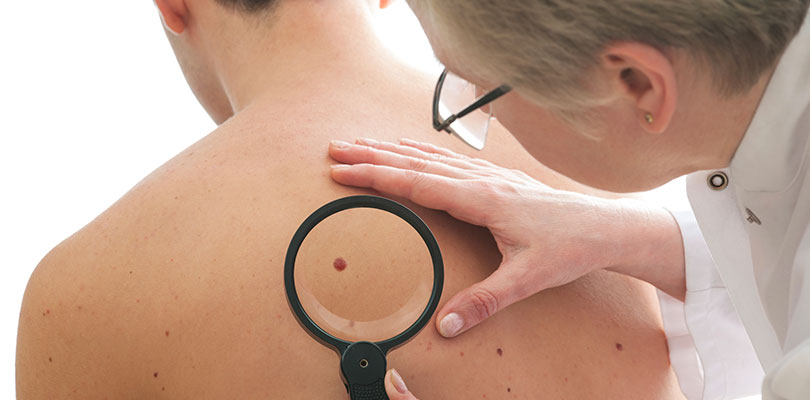Photo Credit: AlexRaths / iStockPhoto.com
How to Check for Cancer
Even if you go to your primary care doctor and dentist regularly, it is a good habit to check yourself for common cancers on a routine basis. Some cancers are not easily identified, whereas others, such as skin cancer, breast cancer, testicular cancer and oral cancer, can be identified fairly easily if you know what to look for.
Skin Cancer
The Skin Cancer Foundation recommends that a head-to-toe self-examination be done monthly. Follow the steps outlined below to perform a self-exam:
- Examine your face closely. Pay close attention to your ears, nose, lips and mouth. Use a hand mirror to get a closer look.
- Inspect the scalp carefully. Use a blow dryer with a mirror or a friend in order to view all areas of the scalp effectively.
- Examine the hands. Make sure to examine in between the fingers, your palms, and under the fingernails. Next move to the wrists and the forearms, front and back.
- Examine all surfaces of the arms. Use a full-length mirror so you can see every angle.
- View the chest, neck and torso. Do not forget to lift the breasts to view the undersides.
- Check your back. Using a hand-held mirror and the full-length mirror, stand with your back to the full-length mirror and examine the back, neck, and shoulders.
- Continuing in the same position, scan lower legs, buttocks and lower back.
- Sitting down, use a mirror to examine the genitals. Examine each leg — check the front and back, thigh and shin, ankles and feet.
Should you find any freckle or bump that is suspicious, it is helpful to know your ABCDEs:
- Asymmetry – the freckle is not symmetrical.
- Border – the border is irregular.
- Color – the color varies or has shades of tan, brown or black, sometimes white, red or blue.
- Diameter – a melanoma is typically greater than 6mm.
- Evolving – a mole that looks different than the rest or is changing in shape, color or size.
Breast Cancer
The National Breast Cancer Foundation recommends performing a self-exam of the breasts monthly. According to Johns Hopkins Medical center, “Forty percent of breast cancers are detected by women who feel a lump, so establishing a regular breast self-exam is very important."
The steps for a breast self-exam are as follows:
- In the shower, use the pads of the fingers and move around the entire breast in a circular pattern from the outside to the center. Include the armpit area. Check both breasts. Note any lumps, thickening or hardened knots.
- In front of a mirror, visually inspect your breasts. First keep your hands at your sides, then raise them over your head. Notice any changes in contour, swelling, dimpling of the skin, or changes in the nipples. Place hands on the hips, flexing chest muscles. Look for dimpling and puckering.
- While lying down, place a pillow behind the right shoulder and the right arm behind the head. Using the left hand, move the fingers around the breast in a circular motion. Use light, medium and firm pressure. Squeeze the nipple to check for discharge. Repeat on the other breast.
Testicular Cancer
According to the Testicular Cancer Society, testicular self-exams should be performed monthly. They note that men find most testicular cancers during a self-exam or by their partner, not by their physician, so doing the exam is important.
The steps for performing a self-exam can be followed below:
- After a warm bath or shower, when the scrotum is relaxed, stand in front of a mirror. Note any swelling of the scrotal skin.
- Examine each testicle with both hands. Place the thumb on the top of the testicle and the index finger and middle finger under the testicle; firmly but gently, roll the testicle between your fingers. Note any irregularities.
- Find the epididymis, a rope-like structure on the back of the testicle. It is important to identify this structure so it is not falsely identified as a lump.
- Repeat the steps on the other testicle.
Oral Cancer
The American Association of Oral and Maxillofacial Surgeons recommends performing an oral cancer self-exam monthly. Doing so can detect cancer in the early stages; oral cancer typically has a high mortality — because it is often diagnosed in the later stages. It is estimated that 42,000 Americans will be diagnosed with oral or pharyngeal cancer this year.
The steps for performing an oral exam can be found below:
- Remove any dentures that may be present.
- Look into the mouth — check and feel inside the lips and the front of the gums.
- Tilting the head back, examine and feel the roof of the mouth.
- Pull the cheeks out to visualize the inner surface and the back of the gums.
- Pull out the tongue; look at all surfaces.
- Feel for any lumps or enlarged lymph nodes in the neck.
What to look for:
- Leukoplakia (white patches of the oral tissue)
- Erythroplakia (red patches)
- Erythroleukoplakia (red and white patches)
- A sore throat that does not heal and bleeds
- Abnormal lump of the mouth and/or neck
- Hoarseness
- Difficulty chewing or swallowing
Should you note anything of concern while performing any of these monthly self-exams, please contact your physician.
